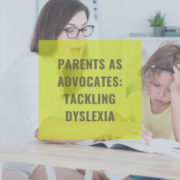Navigating the Journey of Dyslexia Advocacy
October is Learning Disabilities Awareness Month—a dedicated time to raise community awareness about learning disabilities and provide support for all children.
While awareness is crucial, parents of children with dyslexia are intimately familiar with their children’s day-to-day struggles. For these parents, another “A” word holds even greater power—advocacy.
As a parent, no one understands your child better than you do. In advocating for your child’s needs, it’s essential to recognize your unique role and the importance of being their strongest advocate. This blog will guide you through the process of advocating for your child with dyslexia, offering valuable insights, tips, and key information.
- Know Your Child’s Rights Under the Individuals with Disabilities Act (IDEA):
Under the Individuals with Disabilities Act (IDEA), our nation’s special education law, children and their parents or guardians are guaranteed certain protections and rights. Once your child is identified as having a qualifying disability, schools are legally obligated to provide special education services. IDEA also grants parents procedural safeguards, ensuring they are informed and have a voice in every aspect of their child’s special education evaluation and IEP (Individualized Education Program) process. It’s crucial to understand these rights and the associated documentation thoroughly. Don’t hesitate to seek clarification before signing any documents.
- Stay Organized with a Binder:
An essential aspect of effective advocacy is staying organized. Maintain a binder containing all relevant documentation about your child’s diagnosis and evaluations. This should include test results, doctor’s notes, educator’s observations, report cards, writing samples, and academic skill data. This binder keeps essential documents organized and records progress and communication with your child’s educational team.
- Be Prepared for Special Education Meetings:
Being well-prepared for special education meetings is paramount. Your seat at the table matters because you know your child best. Prepare questions in advance and be ready to speak up if answers aren’t clear. Meetings often move swiftly, so don’t hesitate to request additional meetings for clarification. Taking notes during these meetings demonstrates your active involvement and commitment to your child’s special education services.
- Summarize and Follow Up via Email:
After special education meetings, send a summary email outlining the main discussion points and decisions. This ensures everyone is on the same page and provides an opportunity for clarification. If anything remains unclear, your email can initiate further conversation. Request follow-up meetings as needed to address any outstanding issues.
- Establish Clear Expectations:
Communicate with teachers about your expectations, your child’s expectations, and the school’s expectations. Prevent miscommunication and surprises by setting honest, positive, and realistic expectations for your child’s success. Maintain objectivity when receiving feedback from teachers and professionals to foster productive discussions.
In conclusion, October’s Learning Disabilities Awareness Month is an excellent opportunity to underscore the importance of advocacy for children with dyslexia. As a parent, you are uniquely positioned to champion your child’s educational journey. By understanding your child’s rights, staying organized, preparing for meetings, communicating effectively, and setting clear expectations, you can be the most effective advocate for your child’s success.
Keywords: Learning Disabilities Awareness Month, dyslexia, advocacy, parents, special education, IEP, individualized education program, educational rights, communication, expectations








